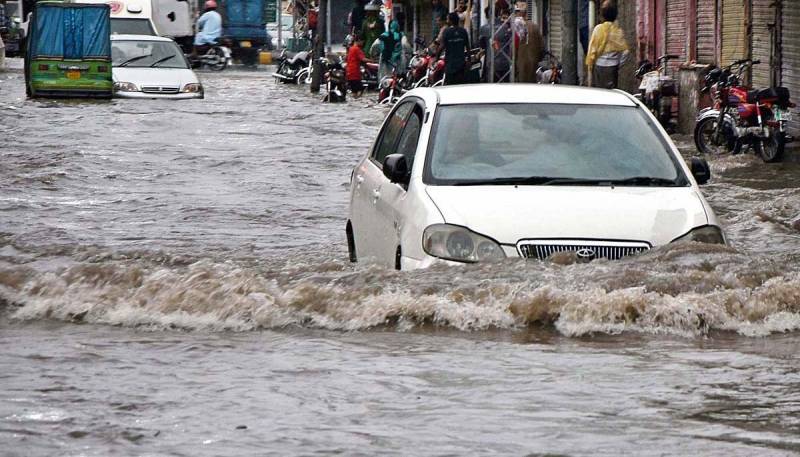Monsoon strikes

Stay tuned with 24 News HD Android App

The monsoon season has arrived. Or I should say the monsoon season has struck, very hard. It has been raining cats and dogs all across Pakistan. A few weeks back, Islamabad was hit hard by the rain. Some say it was a cloud burst, others say it wasn’t. Whatever it was, we can agree on one point, it was definitely a drainage failure. Every now and then, while delivering news from the studio, I have to describe the horrific details of different rural areas in Pakistan being flooded by the monsoon rainfall. While driving through Lahore these days, you can observe water on the roads, water in potholes, water on or near footpaths, and water on the streets. Irresponsible drivers, showing no concern for others, splash water on bikers and those walking on footpaths. Bikers too, play their role in disrupting traffic flow, gathering under bridges to avoid the rain. However, they wait for the rain to stop in such a manner that they do not align themselves to one side of the road, rather they scatter around and disrupt the whole flow of traffic. But let’s just keep social ethics aside for a moment, for we have some major questions to answer right now. Is a drainage and sewage system really a very modern concept? Does it require a significant portion of the budget or is it the fault of our government officials, who are too lethargic to deal with an issue that we have been facing for years now?
You might be surprised, as I was, that the oldest drainage system was found in ruins that were dated to around 4000 BC. It was constructed by the Mesopotamian Empire in Iraq. Archaeologists believe that the most important element utilized by the Mesopotamians was the hydraulic system. Basic hydraulics were established in order to transfer the stormwater and sewage in drains. The second oldest drainage system belongs to the times of 2000 BC. It was designed by the Babylonians. They made drainage pipes with the use of clay. The major purpose of this system was to drain stormwater, as people had bigger homes, which could be flooded easily by storms and rain if they had no proper drainage facility. The next major drainage setup can be observed in the Harappan civilization. Being considered the most ancient civilization of South Asia, it had one of the finest sewerage systems. Harappa, Mohenjo-Daro, and Lothal had a centralized drainage facility established to facilitate each and every street, house, and fort. Baked bricks, with the help of wooden lids and stones, were amalgamated together in such a way that it allowed rain and drainage water to pass through the cities and land into different exit points. I wonder how intelligent the people of that civilization were.
Apart from these “Before Christ” societies, the old written sources confirm that the Byzantine cities too had a proper and well-planned drainage facility. They used ceramic pipes to create a public network of channelling water through the cities. A more modern concept was introduced by Muslims in Spain. The Muslim state Al-Andalus was well planned and designed. Archaeological pieces of evidence prove that a proper water network was laid down into the cities to evacuate wastewaters. It was made obligatory for each citizen to cooperate with and utilize the already established sewer network. Citizens were bound to pay a certain amount to connect their homes with the network. The state utilized the charge to renovate the system now and then to avoid flooding and blockages.
So where does the problem lurk? Is the non-advancement of mechanical equipment the only reason behind floods and mismanagement? Well, not exactly. The high population growth with more urbanization is ultimately causing the degradation of the environment. The increase in the volume of wastewater with a drainage network that has not been upgraded in the last seventy years will definitely cause nothing but destruction. Secondly, climate change is a major problem that not just us but the whole world is facing right now. Climatic changes with heavy rainfall, floods, deforestation, and landslides are paving the way towards greater destruction. What we really need to understand is afforestation is a solution, no doubt, but a long-term one. The government must understand the fact that there is a huge sum of people suffering because of floods every year. It is mandatory to come up with a solution that could reduce their suffering, which is inevitable for them, every year, in the monsoon season.
Humanity has been making use of drainage systems for more than five millennia now. Hence, we can infer that such a facility is not just a basic requirement, but a social responsibility too. Even the people of Harappa were sane enough to rationalize the importance of cleanliness, sophistication, and a hygienic lifestyle. Over time, every growing society prioritized the advancement of such facilities. However, it’s strange to observe how we are losing our grip over such an important necessity. What this society badly requires is the application of basic sanitation principles. The other day while driving through Lahore in heavy rain, I saw a mother sitting in a car with her infant in her lap. The car’s window was open. With a big but soft smile on his face, the kid was enjoying the falling raindrops on his face. All of a sudden the mother held her son’s hand in a praying posture and whispered something in his ears. It was evident that she was telling him to pray for something. The kid, while looking at the sky, repeated the words that his mother had whispered. I was frustrated by the traffic disruption, but this scene made me smile as well. My mood was lifted. I don’t know why. Nevertheless, I hope the kid prayed for this society’s worsening drainage facility, too.
